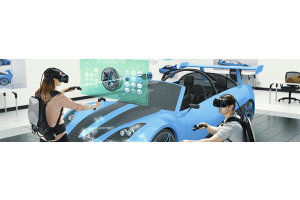We use cookies to offer you a better experience. For more information on how we use cookies you can read our Cookie and Privacy Policy.
What are the Most Demanding PC Games?
August 17, 2019

Let’s jump back to 2007.
2007 was a legendary year in gaming. That’s the year the very first Assassin’s Creed, Mass Effect, Rock Band, Portal, BioShock, and Uncharted games were released. The juggernaut was also released in 2007: Halo 3. Halo 3 was accompanied by such a large amount of hype and fanfare, that many critics agree September 25, 2007 marked the moment that gaming went mainstream.
Another influential title hit shelves that year: Crysis. Crysis is a first-person shooter where the player controls a nanosuit-wearing soldier who’s running and gunning through a mysterious island. Most gamers can’t recall the exact story, but they certainly remember the graphics.
The game was both praised and criticized for its visuals. The graphics were absolutely jaw-dropping, but no computers at the time were capable of running them on their maximum settings. Even today, gamers humorously ask, “But does it run Crysis?” when inquiring about new gaming hardware.
Back to 2019. Are there any Crysis-esque games that push the limits of PC hardware?
You bet! In the last decade, PC games have gotten even more advanced and more graphically demanding. Let’s reevaluate the PC gaming landscape and identify the most demanding games on the market.
What’s our criteria?
We aren’t just determining which is the most graphically demanding PC game. We’re going to determine what the hardest game to run on a PC is, period. Games aren’t just taxing to your graphics card. They’re also taxing on your CPU, memory, and display. We want to know which games make all of your hardware sweat.
Let’s review the areas we’ll be evaluating:
Processor
Graphics cards get the lion’s share of attention when gamers talk about hardware. But the central processing unit (CPU) is just as important for gaming.
As you may or may not know, the CPU processes instructions given by computer programs. A video game is a computer program from which the CPU must process data. The graphics card handles most of the instructions that deal with visuals. But it’s the CPU that handles everything else.
The CPU processes data pertaining to:
- Artificial intelligence
- Physics calculations
- Player movements
- Player interactions with environment
- Multiplayer support
That’s a massive amount of data that must be processed in real-time. Simultaneously, your CPU must also keep your operating system running, along with any other computer programs you have running.
Think about a game like Watch Dogs 2. Consider all the different elements of that game that the CPU processes. First, the processor needs to read the data pertaining to the game’s highly realistic rendition of San Francisco. It doesn’t need to render the visuals, but it needs to sort through the data and send it to the GPU. Then the processor handles all of the CPU characters that populate the city. Then it makes physics calculations as you walk, run, jump, and drive across the city. It also handles game logic - the “rules” of the game that determine how much damage your character can take until he KOs, and so on. And finally, your CPU processes every click of your mouse and tap on your keyboard.
So as you can see, the CPU is just as important as a GPU.
Graphics card
Your graphics card (also known as a graphics processing unit, or GPU) is tasked with rendering all of the game’s visuals. It receives graphics data from the processor and must translate the binary code into an image on your monitor. The GPU reads the data and figures out how to arrange the pixels on your monitor to create the coded image.
When it comes to running your PC game, the graphics card is equally important to the processor. A good graphics card will be able to render a large amount of data in a short span of time. A weaker graphics card won’t be able to keep up with large data streams of graphics information, and that’s when things get ugly on the monitor - textures pop in and out and you suffer from lag [1].
Graphics settings
What’s unique about PC games is that they have different graphics settings, which usually range from low to ultra (sometimes called “very high”). These settings are important because they allow gamers to run all sorts of games regardless of the hardware they have. For example, you might not be able to play a game on “high” graphics because your graphics card is too old, but you can still play the game on “low” graphics.
Here’s the question we were faced with: do we find the game that’s most taxing at standard graphics settings, or maximum graphics settings?
For the purpose of this article, we chose to evaluate games based on their highest graphics settings. What gamer doesn’t want to experience the best graphics a game has to offer? And besides, the games that are insanely demanding at maximum settings are also likely to be demanding at lower settings, too.
What are the most demanding PC games on your computer hardware? Read on to find out.
1. Most demanding PC game on the CPU
Project CARS 2 is the most demanding PC game on your CPU. Check out the recommended hardware requirements:
- OS: Windows 10
- Processor: Intel® Core™ i7 6700K
- Graphics card: NVIDIA® GTX 1080, AMD Radeon RX480
- Memory: 16GB RAM
- Storage: 50GB available hard drive space [2]
For those unfamiliar with the game, Project CARS 2 is a racing simulator in which you hop into the driver’s seat of racing vehicle and race other cars through scenic tracks.
It should be emphasized that the game is a racing simulator and not an arcade racing game. The difference is that arcade racers feature unrealistic physics - the vehicles go through an endless number of crazy collisions and jumps along the racetrack that would be catastrophic in real life (it’s like watching a Fast and the Furious movie). A racing simulator, on the other hand, features physics and car handling that’s more akin to the way real cars drive. That’s important, because it’s the game’s realistic physics that will work your CPU.
Hefty hardware requirements
The key specs are revealing. First, the game requires a massive amount of available hard drive space to install - 50GB. That’s a testament to how much data the game contains. You wouldn’t think a game that consists primarily of “Start to Finish” race tracks would contain so much necessary information. But it does. In fact, it contains the same amount of data as Watch Dogs 2, the open world game that features a virtual rendition of San Francisco.
This is undoubtedly due to the high-quality graphics. On its highest settings, Project CARS 2 is one of the most photorealistic games on the market. You could look at still images of the game and mistake it for a photograph taken at a real-life Grand Prix event. Photorealistic graphics require a solid amount of data.
The second interesting spec is the processing requirement. To run the game at its best settings, it’s recommended you have an Intel Core i7 6700K processor. Of all the graphically demanding games that have been released over the past few years, this might be the heftiest CPU requirement of them all. But it’s an accurate recommendation. Here’s why.
Complicated physics
Project CARS 2 prides itself on its ultra-realistic physics engine. We can sort the physics calculations into three groups:
- Driving
- Race tracks
- Weather
The driving physics are the most obvious calculations: acceleration, deceleration, turning, collisions, and the like. These physics aren’t unique to Project CARS 2 and they’re not very taxing on your CPU.
The race track physics are slightly more complicated. Like real race tracks, the tracks in Project CARS 2 suffer slight wear-and-tear with each lap. As the race progresses, areas of the race track get slightly worn, and the overall race track gets warmer from all the racing vehicles. All of this affects the way your vehicle drives. But, still, these physics aren’t super demanding.
It’s the added weather effects that make Project CARS 2 a difficult game to run. You can set certain weather conditions during a race, like thunderstorms or blizzards. The realism of the weather physics demands a ton of processing power from your CPU [3].
Smart AI
Sometimes the AI opponents in Project CARS 2 suffer on certain racetracks, but they’re mostly intelligent. You get the sense that your virtual opponents are very capable of beating you in a race, and that they’re strategizing as they drive. These AI calculations also draw upon your CPU.
Fast speeds
It’s a racing game, so you naturally blast through the game world at blazing speeds. Because you’re moving so quickly, your CPU has got to work fast to send the visual information to your GPU so you won’t suffer from pop-up textures.
Death by a thousand cuts
It might seem surprising to some that Project CARS 2 is the most demanding PC game on your CPU. But all of the processing-intensive features add up - great graphics, complicated physics, smart AI, and fast camera movement - resulting in the game’s rigorous hardware requirements.
2. Most graphically demanding game
Assassin’s Creed: Odyssey is the most graphically demanding PC game. The latest Assassin’s Creed game requires a good CPU and a very good graphics card. Check out the hardware requirements if you want to run the game at its highest 4K resolution:
- OS: Windows 10 64-bit
- Processor: AMD Ryzen 1700X (3.8 GHz), Intel Core i7 7700 (4.2 GHz)
- Graphics card: AMD Vega 64, NVIDIA GeForce GTX 1080 (8GB VRAM with Shader Model 5.0)
- Memory: 16GB RAM
- Storage: 46GB available hard drive space [4]
Massive game world
Assassin’s Creed: Odyssey is set in Ancient Greece, and so the game world is a huge interpretation of the Ancient Greek mainland, islands, and Aegean Sea. The map is twice as large as the previous Assassin’s Creed game, and it’s dotted with small towns, big cities, vessels, wildlife, and the inhabitants of Ancient Greece. It’s arguably one of the greatest, most immersive game worlds ever produced. Understandably, it requires a huge load of work from your graphics card.
The GPU wouldn’t be strained so much if Assassin’s Creed: Odyssey didn’t have such an incredible draw distance (draw distance is a technical term for “being able to see to very far away from you”). When you’re standing on a hillside above the Greek countryside, you can see far off into the horizon and glimpse hazy settlements, seas, and landscapes. It’s stunning how much detail can be rendered in one frame, and that’s what gives the game such an epic scope. It’s amazing how there aren’t any pop-up textures given how vast the rendered landscape is.
Epic detail
Things also look great on a smaller scale. The grass and Grecian cornfields are so detailed, it seems as if you could pick individual blades and stalks. The textures look great, and it’s fun to see how the changing light effects influence the look and feel of the ancient cities and forests. While it’s a challenge for a good GPU to render Odyssey’s game world in large swaths, it’s also a considerable undertaking to render all of the smaller effects - especially on the highest settings. The devil is in the detail, as they say.
Which HP computers can run these games?
HP® produces a variety of computers that are ready-made for gaming. These gaming rigs can tackle the most demanding PC games, like Project CARS 2 and Assassin’s Creed: Odyssey.
If you’re looking for a great gaming desktop, check out the HP OMEN desktop gaming rigs. The HP OMEN series is flashy and futuristic - your friends and gaming tournament competitors will marvel at the awesome style. But they’re not style over substance.
The HP OMEN computers are equipped with either Intel or AMD processors, depending on the model. As far as graphics cards are concerned, models are equipped with either NVIDIA GeForce GTX graphics cards or AMD Radeon RX 580 graphics cards. You can install up to 32GB RAM in each model. All of this hardware is more than capable of running Project CARS 2 and Assassin’s Creed: Odyssey at high settings.
But you can also find a variety of HP® computers with NVIDIA graphics cards and powerful processors. Although they don’t all fall under the HP OMEN brand, many of the models are strong enough to take on the aforementioned games.
And let’s not forget about those gamers who prefer laptops. The HP i7 gaming laptops are equipped for power PC gaming. They can also handle our two gaming bigwigs because they’re equipped with Intel Core i7 processors, and they all have capable NVIDIA graphics cards.
What’s great about these HP gaming computers is that they don’t only feature quality hardware. They’re also designed to properly ventilate the interior of the computer so that the hardware doesn’t overheat - which could outright destroy your CPU and GPU.
If you’re going to be running intensive games on high graphics settings, your hardware is going to get hot and sweaty from working so hard. HP gaming computers have quality ventilation to ensure that your hardware will stay cool and last longer, so play to your heart’s content and enjoy every minute of it.
About the Author: Zach Cabading is a contributing writer for HP® Tech Takes. Zach is a content creation specialist based in Southern California, and creates a variety of content for the tech industry.






